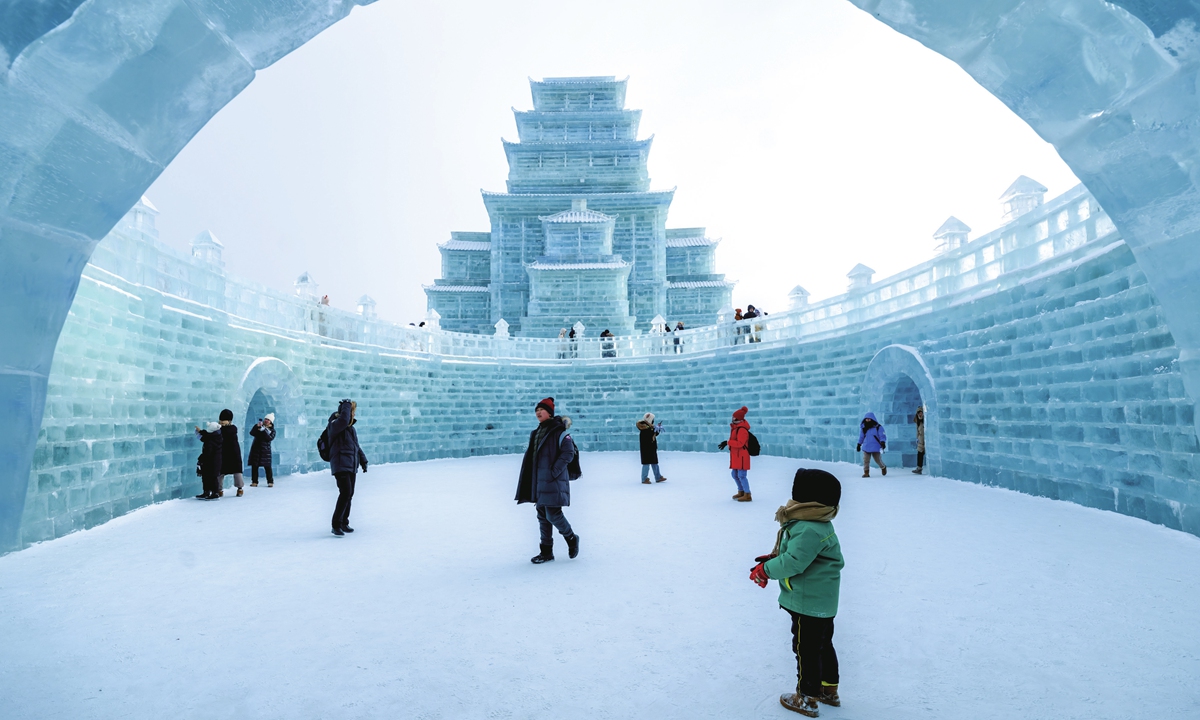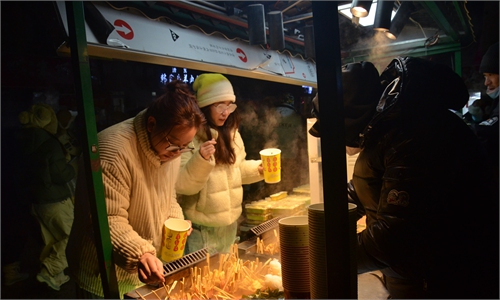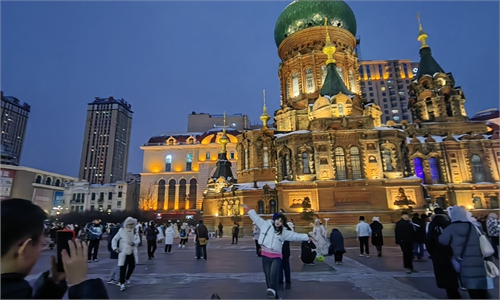New Dynamics in New Year: Ice and snow tourism transforms, fuels consumer spending, charting path for Northeast China's revitalization

Tourists visit the Harbin Ice-Snow World in Harbin, Northeast China's Heilongjiang Province on January 13, 2024. Photo: VCG
While temperatures drop to around -25 C, the cold weather does not deter the enthusiasm of tourists from home and abroad visiting Harbin, the capital city of Northeast China's Heilongjiang Province.
Renowned for its ice and snow attractions, Harbin has gained momentum as a prime example of how the hospitality industry can drive and catalyze diversification across industries, boosting consumer spending and paving the way for the revitalization of Northeast China.
The momentum of ice and snow-themed travel is forecast to keep going through the upcoming holidays for the Spring Festival, the Chinese Lunar New Year, which starts from February 10 this year.
During the peak season for tourists between February 9 to 17, snow and ice tourism sites are among the most popular destinations nationwide, seeing surging numbers of ticket orders, according to the online travel agency Trip.com.
The bustling ice and snow tourism in Harbin has not only stimulated winter tourism but has also boosted the development of supporting industries such as winter clothing, food, and accommodation, industry insiders and experts said. This has driven consumer demand and revitalized the local economic landscape.
Tourism flourishes
Harbin's ice and snow tourism not only brings joy to visitors but also offers them a new perspective on this northeastern city, particularly for those from outside the region. Adrien, a French tourist, who recently visited Harbin with his wife to experience the enchanting ice and snow scenery firsthand. His experience left a deep impression on him.
"We have noticed that Harbin is becoming a more and more popular tourism destination. The amazing winter landscapes with ice and snow activities remind me of those in my hometown in France, my wife and I spent a great time in the snow valley in the outskirts of the city," Adrien told the Global Times in front of the St. Sophia Cathedral, an iconic building and also a tourist attraction, in downtown Harbin.
"It's a wonderful spot to visit and we really enjoyed the views and skiing. We have many options for skiing in Europe, now Harbin is one of the new options," Adrien said.
Clayton Matta, resort general manager, Club Med in Yabuli, a renowned Harbin ski resort, came to Yabuli in 2011 and he felt that now there have been massive changes in Harbin. "We used to be the only international hotel here and now more and more are coming around because of the rising trend of snow and ice business, which is the exciting part for me," Matta told the Global Times on Tuesday.
"There is definitely excess spillover from tourism boom in the region, we have seen our occupancy increase and we are seeing about 8,000 tourists with us with a large increase in international guests since December," Matta said.
The general manager praised the local government's supports in helping the business. "We have a fantastic relationship with the local government and the committees, whether it will be offering local cuisine, hiring local staff, communicating with the local authorities to help build the area including infrastructure around the resort club," Matta said.
"In the past few years, the pandemic has greatly restricted travel and posed significant challenges to tourism. People have longed to explore and travel, and this desire has been accumulating over time. Harbin, the most captivating winter destinations this year, has finally fulfilled that longing," commented Xu Shaobo, executive chairman of the Harbin Private Enterprise Chamber of Commerce, told the Global Times.
Driven by the ice and snow tourism, the number of registered tourism-related businesses in Harbin has significantly increased this year. Data from the Municipal Market Regulation Bureau of Harbin shows that, in the first half of January (January 1 to 15, 2024), there were 927 newly-registered market entities in the city engaging in tourism, accommodation, and catering, a year-on-year increase of 161.86 percent.
Bustling tourism in Harbin is propelling the rapid recovery of the national cultural and tourism industry, and the cold winter is nurturing a "hot economy," Xu added.
Beyond ice and snow
People-to people exchanges boosted by tourism has enhanced the city's popularity, which in turn has let Harbin's private enterprises somehow grow their reputation, providing favorable conditions and opportunities for attracting investors, Li Cheng, chairman of Harbin Private Enterprise Chamber of Commerce told the Global Times on Monday.
The chamber chair's remarks did not come out of the blue. During a recent trip to the region, the Global Times reporter spoke with local business people and captured a rising enthusiasm and confidence that extends beyond the appeal of ice and snow tourism.
Chen, who runs a photography studio near the St. Sophia Cathedral in Harbin, said that street photography at the St. Sophia Cathedral has become popular from the New Year's Day holidays onwards, "I used to do the photography business in Xishuangbanna, a famous tourist destination located in Southwest China's Yunnan Province, now I came back to my hometown Harbin after all the buzz this winter, and I can earn 10,000-15,000 yuan ($1,409-$2,113) per day, a big fortune with more pride," he said with a big smile on his face.
Harbin's street photography industry is doing very well recently, the Global Times reporter found that on Meituan Dianping, a widely used lifestyle platform, there are more than 50 registered photography studios near the St. Sophia Cathedral so far.
"More and more tourists are coming, and the upcoming Spring Festival holidays will definitely deliver a new wave of customers and boost the local economy," Chen said.
Ding Guangjue, a manager of Heilongjiang-based Hop Lion feather and down manufacturing company, told the Global Times that his company has posted a record profit for this winter by selling down productions, mainly fueled by hit ice and snow tourism in Harbin.
In terms of advantages, Harbin is home to high quality goose down compared to those produced in southern China, allowing for a one-third of additional selling price, Ding said.
"I think the city has enormous market potential with more and more tourists visiting from all around the world, it is a great opportunity for us to double our investment in the northeastern region," the manager said, in the hope that the company can expand the supply chains production facilities in the feather business in the region.
The consumption boom can be seen in much wider region not just in Harbin but the whole northeast China.
Xin Dawei, a member of the Heilongjiang Provincial Committee of Chinese People's Political Consultative Conference, told the Global Times that he has recently put forward a proposal on boosting local goose breeding, farming, and the deep processing industry, developing a new brand surrounding geese-related sectors in the region.
The 2025 Asian Winter Games are to be held in Harbin, which will create more demand for winter outfits such as ski suits and down jackets. There is a great development opportunity for the new sectors including feather and down manufacturing in Heilongjiang, with government support, Xin said.
Other industries, such as the fresh fruit industry, have also gained momentum.
In Fuyuan, Heilongjiang, the local cranberry planting business is flourishing.
Li Feng, a manager of the cranberry planting company Red Sea Farm, told the Global Times that his company has enjoyed a bumper harvest of cranberries, reaching a record high of 1,500 tons and generating annual sales revenue of 40 million yuan, thanks to the booming tourism in the city.
Covering over 280 hectares, Li's farm is one of the country's largest cranberry planting bases, growing cranberries has created jobs opportunities for local farmers and helpe them to enjoy higher incomes. It also helped filling the domestic market gap of heavily relying on imported fresh cranberries.
"We plan to leverage policy dividends, tourism resources, and the opportunities presented by the upcoming Asian Winter Games in 2025 to strengthen economic and trade ties with the Shanghai Cooperation Organization members and promote industrial revitalization in Northeast China," Li Cheng noted.
"We believe that the prospect of revitalization of Northeast China is limitless," the chamber chair said.



